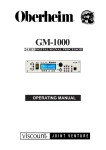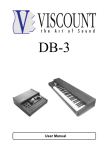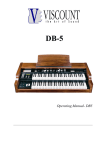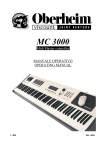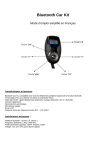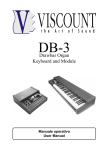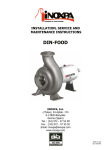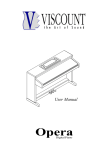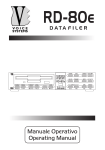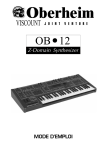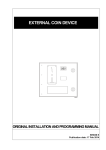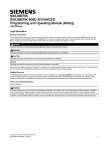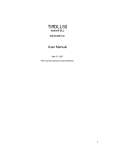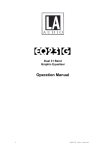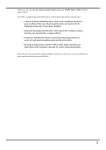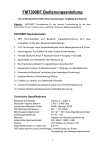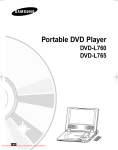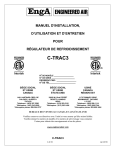Download oberheim gm400 ownersmanual
Transcript
Oberheim - VISCOUNT JOINT VENTURE GM-400 DIGITAL SIGNAL PROCESSOR OPERATING MANUAL CAUTION RISK OF ELECTRIC SHOCK DO NOT OPEN WARNING! TO REDUCE THE DANGER OF ELECTRIC SHOCK: DO NOT REMOVE COVER (OR BACK) DO NOT EXPOSE THIS APPLIANCE TO RAIN OR MOISTURE NO USER SERVICEABLE PARTS INSIDE REFER SERVICING TO QUALIFIED SERVICE PERSONNEL This simbol is intended to alert the user to the presence of important operating and maintenance (servicing) instructions in the literature accompanying the appliance. This simbol is intended to alert the user to the presence of uninsulated “dangerous voltage“ within the product’s enclouser that may be of sufficient magnitude to constitute a risk of electronic shock to persons. “INSTRUCTIONS PERTAINING TO A RISK OF FIRE, ELECTRIC SHOCK, OR INJURY TO PERSONS“ IMPORTANT SAFETY INSTRUCTIONS WARNING: When using electric products, basic precautions should always be fallowed, including the following: 1) Read all instructions before using the product. 2) To reduce risk of injury, close supervision is necessary when product is used near children. 3) Do note this product near water – for example, near a batnub, washbowl, kitchen sink, in a wet basement, or near a swimming pool, or the like. 4) This product, either alone or in combination with an amplifier and headphones or speakers, may be capable of producing sound levels that could cause permanent hearing loss. Do not operate for a long period of time in high volume level or at a level that is unconfortable. If you experience any hearing loss or ringing in the ears, you should consult an audiologist. 5) This products should be located away from heat sources such as radiators, heat register, or other products that produce heat. 6) The power supply cord of the instrument should be unplugged from the outlet when left unused for a long period of time. 7) Care should be taken so that objects do not fall and liquids are not spilled into the enclosure of the instrument. 8) The products should be serviced by qualified personnel when: a. The power supply cord or the plug has been demaged; or b. Objects have fallen, or liquid has been spilled into the product; or c. The products has been exposed to rain; or d. The products does not appear to operate normally or exibist a marked change in performance; or e. The products has been dropped, or the enclosure demaged. 9) Do not attemp to service the product beyond that described in the usermaintenance instructions. All other servicing should be referred to qualified personnel. Oberheim GM 400 Digital Signal Processor CONTENTS Contents: .................................................................................................... page 69 1. Introduction: 1.1 Precaution ............................................................................................. page 71 2. Description of controls and connectors: 2.1 Front panel.............................................................................................. page 72 2.2 Rear panel...............................................................................................page 73 3. Installation and instructions for use: 3.1 Connection examples.............................................................................. page 74 3.2 Some advices for correct use of the GM 400............................................page 75 3.3 Structure of the GM 400........................................................................ page 77 4. Play mode: 4.1 Keys and controls.................................................................................... page 78 4.2 Selecting a memorized patch...................................................................page 79 4.3 Programming .......................................................................................... page 80 5. Edit mode: 5.1 Keys and controls.................................................................................... page 81 5.2 Master level ........................................................................................... page 84 5.3 Memorizing a patch..................................................................................page 84 6. Effects: .................................................................................................... page 86 6.1 Compressor (CMP) ................................................................................ page 87 6.2 Distortion (DST) .....................................................................................page 89 6.3 Equalizer (EQ) ....................................................................................... page 91 6.4 Amp simulator (AMP) .............................................................................page 94 6.5 Modulation (MOD) ................................................................................. page 96 6.6 Special effects 1 (SP1) .......................................................................... page 101 6.7 Special effects 2 (SP2) .......................................................................... page 104 6.8 Delay (DLY) ........................................................................................... page 107 6.9 Reverberation (REV) ............................................................................. page 111 6.10 Noise gate (NG) ...................................................................................page 124 6.11 The Midi Foot Controller page................................................................page 124 - 69 - Oberheim GM 400 Digital Signal Processor 7. Utility Mode: 7.1 Midi ........................................................................................................ page 126 7.2 Program Table ....................................................................................... page 128 7.3 Dump ..................................................................................................... page 129 7.4 Tuner ..................................................................................................... page 130 8. Initialization procedure: 8.1 Factory settings ..................................................................................... page 131 8.2 Dsp self-test ...........................................................................................page 132 9. Annex: 9.1 Types of connectors used........................................................................page 133 9.2 Glossary of terms used............................................................................ page 133 10. Technical specifications........................................................................page 134 Midi Implementation Chart ...........................................................................page 135 - 70 - Oberheim GM 400 Digital Signal Processor 1. INTRODUCTION 1.1 PRECAUTION The following is a list of a number of simple precautions to be adopted when using and maintaining the instrument in order to avoid damage to its mechanical and electronic structures: • To avoid the risk of electric shock, never make the connections or use the instrument with wet hands. • Never apply excessive force to the instrument's mechanical parts and keys. • Do not stress the instrument in transit or during use. • Do not place the instrument close to heat sources, in excessively damp or dusty places or close to strong magnetic fields. • When possible, do not place the instrument close to units which generate strong interference, such as radio and TV sets, monitors, etc. • Never insert foreign bodies or liquids of any kind inside the instrument, for any reason. • Never use solvents on the instrument's finishes. To clean, use only a soft cloth dipped in water. • The inside of the instrument does not contain any parts requiring maintenance by the user. Never attempt to carry out repairs or modifications to the instrument; always contact qualified personnel for any repairs. • Only connect foot-switches with normally open contact. Prolonged use of unsuitable pedal units causes serious damage to the instrument's electronic components. • Disconnect the power supply lead from the mains socket if the instrument is to be out of use for long periods. • Use only an original power adaptor or one which complies in full with the manufacturer's specifications. Check that the mains voltage is as indicated on the body of the adaptor. • Do not expose the instrument to excessive heat sources, direct sunlight, excessive vibration or violent knocks. • Before moving the instrument, always disconnect all wires. - 71 - Oberheim GM 400 Digital Signal Processor 2. DESCRIPTION OF CONTROLS AND CONNECTORS 2.1 FRONT PANEL 2 1 5 3 6 9 4 7 8 10 12 13 11 14 15 1. Phones Output: this socket is a headphones output which allows the GM 400 to be used even without connection to an amplification system. 2. Phones Level: used to regulate the volume of the signal sent to the PHONES OUTPUT. 3. Guitar Input: dedicated input socket for connection of a guitar. 4. Input Level: regulates the quantity of signal supplied as input to the GM 400. This setting is active for both the front and the rear connectors. 5. Lcd Contrast: regulates the contrast of the liquid crystal display (LCD). 6. Display: backlit display consisting of 2 lines of 40 characters each used to display various information, such as the number and name of the memory to be used, the programming parameters or the input level setting. 7. Cursor: the four illuminated green keys allow the user to move the flashing cursor around the display in order to select a parameter for modification. 8. Encoder: data input device which can be used to modify the values selected using the cursor keys. Turn clockwise to increase the selected value, or anti-clockwise to decrease. 9. Edit key, 10. Compare key, 11. Utility key, 12. Enter/Write key, 13. Exit key, 14. Bypass key: these keys provide all the main functions needed for using and programming the GM 400. 15. Power key: key used for switching the instrument on and off. - 72 - Oberheim GM 400 Digital Signal Processor 2.2 REAR PANEL 16 17 18 19 20 21 22 23 24 25 16. Foot Controller: connector for connection of the Oberheim FC 3000 foot controller (optional). 17. Hold Switch: jack for connection of an optional foot-switch which activates the hold delay function (infinite repetition of a memorized phrase). 18. Tap Switch: jack for connection of an optional foot-switch allowing the tap delay speed to be set. 19. Midi In: five pin DIN connector for reception of Midi messages from a remote Midi source. 20. Midi Out: five pin DIN connector for transmission of Midi messages generated by the GM 400. 21. Midi Thru: five pin DIN connector which retransmits the MIDI codes as output exactly as they are received by the Midi In connector. Used to create a chain of Midi devices. 22. L/Mono - R Input: jack for connection of a remote source to the GM 400. There is a choice between a stereo connection, using the two inputs simultaneously (the recommended option) and a mono connection using the L/Mono connector only. The front Guitar Input connector has precedence over the rear Input connectors. These connectors are of balanced type. 23. L/Mono - R Output: the signal processed by the GM 400 leaves the instrument from these two jacks. There is a choice between a stereo connection, using the two inputs simultaneously (the recommended option) and a mono connection using the L/Mono connector only. These connectors are of balanced type. 24. Cable retainer plate: allows the user to clamp the cable leading from the adaptor securely in place in order to avoid accidental disconnections. 25. AC adaptor: connector to take the plug of the adaptor supplied (AC 10.5 V). - 73 - Oberheim GM 400 Digital Signal Processor 3. INSTALLATION AND INSTRUCTIONS FOR USE 3.1 INSTALLATION P.A. System Mixer Ch. Input P.A. System Adaptor 10.5 volts Midi unit Midi controller Midi Out Midi In Foot controller Fc 3000 (optional) Headphones Foot switches Guitar/Bass Guitar amplifer effects send P.A. System or Ampli P.A. System or Ampli Guitar Audio connections. • use only good quality screened cables. • make the audio connections first and then the mains connection. Mains connection. • make sure that the mains voltage is as indicated on the instrument. • to disconnect the power supply always take hold of the adaptor and do not pull on its lead. - 74 - Oberheim GM 400 Digital Signal Processor • disconnect the power supply if the instrument is to be out of use for a long period. 3.2 SOME ADVICE ABOUT CORRECT USE OF THE GM 400 Switch-on. Before making all the connections make sure that the amplification system volume is turned down to the minimum setting. Switch on the GM 400 and then adjust the system volume again. Otherwise, always switch on the GM 400 first and then the amplification system. Input level. Each instrument has its own output level which may vary depending on circumstances. In order to obtain the best performance from the GM 400, the input level must be adjusted to suit the instrument connected. This simple procedure will ensure that the right amount of signal is sent to the effects processor in order to avoid distortion if the signal is too strong or hissing if the signal is too weak. Start the operation by turning the input trimmer to zero and pressing the Exit key while the display is showing the main menu page: the display will show: At this point, send the signal to the GM 400 and start to turn the Input trimmer clockwise until the signal brings the following onto the display. optimum range -24 dB -18dB -12dB -6 dB -3 dB 0 dB At this point, reduce the input volume until >>ovl<< (the abbreviation of overload, indicating an input circuit overload) no longer appears on the display. The illustration shows the - 75 - Oberheim GM 400 Digital Signal Processor optimum operating range, between -12 dB and -3 dB. Press Exit to return to the main video page. The input signal level can also be constantly monitored from the main video page, using the bars on the left of the display and illustrated below: input level Output level. The MASTER LEVEL (general output level) shown on the main video page: must be regulated in the same way as the input level in order to adapt the output volume to that of the equipment connected to the OUTPUT(S). Since this parameter can also be memorized, more details of how it operates will be described in later sections. Digital technology and levels. The GM 400 is an all-digital instrument: this means that some simple rules have to be followed during programming. In the digital technology, the maximum permitted dynamic threshold is 0 dB; above this level, even if it is only reached and exceeded for one moment, so-called digital distortion is created. Digital distortion has nothing to do with the distortion often required by guitarists, and generates an extremely unpleasant effect often mistakenly thought to be a real malfunction of the equipment. Since the GM 400 is equipped with filters with an operating range of +/- 14 dB and it is possible to add together the action of a number of filters operating simultaneously, the threshold of 0 dB may be exceeded. This must therefore be borne in mind when programming the GM 400, with frequent checks on the amplification gain introduced by the filters mentioned above by means of the bypass functions described in the PLAY MODE and EDIT MODE sections. Adjusting the display contrast. The GM 400 is equipped with a large backlit LCD (liquid crystal display). In view of the characteristics of the LCD system, the contrast has to be adjusted to suit the angle from which the operator looks at it. A trimmer marked CONTRAST on the left of the panel is provided for this purpose. - 76 - Oberheim GM 400 Digital Signal Processor 3.3 STRUCTURE OF THE GM 400 Memory configuration. The memory of the GM 400 is divided into three banks: A, B and C. Each of them contains 128 memory locations (which from now on we will call patches), giving a total of 384. They are all at the disposal of the user, who can program them as preferred. The original factory programming settings for the 128 patches in bank A are maintained permanently in a separate memory and can be recalled at any moment using a special procedure described in point 8.1 FACTORY SETTINGS. Groups and effects. The GM 400 is designed to process the signal with up to 9 EFFECTS which can be programmed at any one time. In addition, there is also a constantly active, programmable Noise Gate (NG). The effects are obtained by means of more than thirty algorithms and are arranged into categories or GROUPS. Each group is able to contain up to 5 different effects of the user's choice, and only one of them can be made active. There are 9 groups available, and this gives the maximum number of effects which can be used simultaneously (plus the noise gate, which is always active): - COMPRESSOR (CMP): Compressor, Limiter, Dynamic-Processor. - DISTORTER (DST): Distortion, Overdrive, Crunch. - EQUALIZER (EQ): Graphic, Guitar, Parametric. - AMP SIMULATOR (AMP): Guitar, Bass. - MODULATION (MOD): Chorus, Flanger, Phaser, Tremolo, Vibrato. - SPECIAL EFFECTS 1 (SP1): Wha-Wha, Double Combination, Double Chorus, Fade-In. - SPECIAL EFFECTS 2 (SP2): Pitch Shift 1, Pitch Shift 2, 4 Voice Chorus. - DELAY (DLY): Standard, Tap, Stereo, Multi, Metronome. - REVERB (REV): Reverb, Gate Reverb, Virtual Chamber. This can all be summed up by a simple chart: PATCH Input Output CMP DST EQ AMP M0D SP1 SP2 DLY REV Comp Limit Dyn-p Grap Guit Para Guit Bass Chor Flang Phas Trem Vibr Wha Comb 2 Ch. Fade Psh1 Psh2 4 Ch. Stan Tap Ster Multi Metr Rev Gate Virt Dist Over Crun - 77 - NG Oberheim GM 400 Digital Signal Processor 4. PLAY MODE The section which follows will describe the PLAY MODE: we will discuss the way in which the GM 400 will be used while the patches are being played. The next section, entitled EDIT MODE, will describe the procedure for programming a patch. This section will refer almost only to the main video page. 4.1 KEYS AND CONTROLS Cursor. Four green illuminated keys to the right of the display and on the left of the Value Encoder are called CURSOR keys. They allow the user to move the flashing cursor, used to select a parameter to be modified, around the display. The top key moves the cursor upwards, the key on the right moves the cursor to the right, and so on. Value. Once the parameter to be modified has been selected, the Value Encoder allows the user to vary its value. Turn the knob clockwise to increase the selected value or anti-clockwise to decrease. The encoder works dynamically; in other words, the speed at which it is turned establishes the speed at which the selected value is varied. General bypass. To listen to the signal exactly as it reaches the INPUT socket, the user can completely bypass the algorithms which process the signal by pressing the BYPASS key with the main menu page on the screen. To confirm this operation, the light in the BYPASS key will begin to flash. Press the BYPASS key again (the light remains constantly on) to return to the initial conditions. This type of bypass is referred to as a GENERAL BYPASS to distinguish it from the LOCAL BYPASS to be described in the EDIT MODE section. Phones output. This socket allows the user to listen to the results of the GM 400 signal processing on headphones. Once the jack has been connected to the PHONES OUTPUT socket on the left of the panel, optimize the playback volume as preferred using the PHONES LEVEL trimmer immediately above the PHONES OUTPUT socket. - 78 - Oberheim GM 400 Digital Signal Processor • CAUTION !!: Excessively high playing volumes may seriously damage your hearing: keep the volume within reasonable limits. 4.2 SELECTING A MEMORIZED PATCH Play mode indicator Foot controller Memory bank General output volume Memory patch Patch name Changing the memory bank. To select a memory bank other than the one which is active: • Locate the flashing cursor on the memory bank indication using the CURSOR keys. • Turn the VALUE encoder until the required memory bank is displayed. Changing the memory patch. To select a memory patch other than the one which is active: • Locate the flashing cursor on the memory patch indication using the CURSOR keys. • Turn the VALUE encoder until the required memory patch is displayed. Master level. The MASTER LEVEL parameter controls the general output level of the selected memory patch: the setting is memorized together with the patch itself. Note that this level is not an absolute value but depends on the settings made during programming of the individual groups active. To modify the MASTER LEVEL value: • Use the CURSOR keys to locate the flashing cursor on the MASTER LEVEL parameter. • Turn the VALUE encoder until a playback volume suitable to requirements is obtained. - 79 - Oberheim GM 400 Digital Signal Processor • CAUTION !!: an displayed on the right of the words "play mode"indicates that this modification has not been memorized in the patch. To make the modification permanent, refer to point 5.3 MEMORIZING A PATCH in the EDIT MODE section. 4.3 PROGRAMMING In PLAY MODE "programming" refers to the operations which can be performed on the instrument without necessarily having to carry out a complex session with substantial modification of the processing parameters, for which the EDIT MODE is required. The Group levels. Press the COMPARE key with the main video page on the screen to access the video page which allows the levels of each individual group to be adjusted. These parameters regulate the way in which the active groups affect the signal to be processed. The active groups are those which have been included in the processing chain during the programming phase and are not in OFF or LOCAL BYPASS status (the LOCAL BYPASS status is different from the GENERAL BYPASS already discussed and will be described in the EDIT MODE section). • N.B.: the level of a group in local bypass or OFF status can be modified, but this will have no effect on the signal. The parameter modified consists of the effect send level (EFFECT LEVEL - see section 6. EFFECTS for further information) and allows the user to set the influence of the specific group within the processing chain, with values between 0 and 100. The only exception is the DST group, which does not include parameters for which there is differentiation between the level of the direct signal and that of the processed signal: in this case, the parameter controlled (the only one with values between 0 and 64) will be the DRIVE (distortion intensity) value, which is certainly the most significant parameter in the group concerned. To modify the operating level of a group: • Use the CURSOR keys to locate the flashing cursor on the group level to be modified. • Turn the VALUE encoder until an effect suitable to requirements is obtained (it may be necessary to vary the values of more than one group to obtain the desired results). - 80 - Oberheim GM 400 Digital Signal Processor • CAUTION !!: an displayed on the right of the words "play mode" indicates that this modification has not been memorized in the patch. To make the modification permanent, refer to WRITE MODE in the EDIT MODE section. Press the Exit key to return to the main menu page. 5. EDIT MODE The section which follows will describe the EDIT MODE operating method, or in other words we will discuss the way in which the GM 400 will be used during programming of the patches. In EDIT MODE, the operator can carry out all the procedures relating to modification of the parameters connected to the programming of a patch. The procedure for saving a new or modified patch in one of the 384 locations available will also be explained. 5.1 KEYS AND CONTROLS For use of the CURSOR keys and the VALUE encoder, see PLAY MODE section. Edit and Exit keys. The EDIT key gives access to the EDIT pages. Once the EDIT function has been accessed, this key allows the user to display pages after those shown on the display, in accordance with the instrument's structural hierarchy. The following is a simple example: MAIN MENU PAGE EDIT MAIN EDIT PAGE EDIT GROUP EDIT PAGE - 81 - Oberheim GM 400 Digital Signal Processor EDIT 1st EFFECT EDIT PAGE EDIT 2ND EFFECT EDIT PAGE (IF PRESENT) .... The red light in the EDIT key will remain on as long as the edit page shown on the display is not the last in the sequence. The EXIT key works in exactly the opposite way to the EDIT key: it allows the user to move one page back from the one shown on the display, passing through the hierarchical structure in the opposite direction to that explained for the EDIT key: EFFECT EDIT PAGE EXIT GROUP EDIT PAGE EXIT MAIN EDIT PAGE EXIT MAIN MENU PAGE Enter/Write key. This key has two functions: • when its light is on: the patch writing function (WRITE MODE) described later in point 5.3 MEMORIZING A PATCH below is active. • when its light is flashing: it allows the user to choose between OFF and BYPASS (BYP) status for a group selected in the main edit video page. Press the EDIT key from the main menu page to obtain the main edit page: - 82 - Oberheim GM 400 Digital Signal Processor To set a group in OFF or BYPASS status: Select the group using the CURSOR keys or the VALUE encoder. Press the ENTER/WRITE key (the display will show OFF/BYP in alternation). Press the EXIT key to return to the main menu page. • when the light is off: no function available. Bypass key. The BYPASS key also provides two functions, but in this case the procedure obtained depends on the video page on the screen: • main video page: as we already know, this key provides a GENERAL BYPASS of the entire chain of effects, or in other words allows the user to listen to the input signal unchanged. Pressing the key provides two conditions: light on: the processing chain is active. light flashing: multieffect system in GENERAL BYPASS status. • in the main edit video page: allows the user to choose between BYPASS (BYP) and ON status for the selected group. • in subsequent edit pages: provides a LOCAL BYPASS, meaning that it switches the selected group only (e.g. DST or CMP) into BYPASS status. We will try to give a rapid explanation of the difference between these types of BYPASS and the types already seen, in order to prevent misunderstandings and allow operators to use the GM 400 correctly. The LOCAL BYPASS function cuts out one group (e.g DISTORTION, EQ or MODULATION), while the GENERAL BYPASS disables the entire chain of effects simultaneously. It must be underlined that the two types of BYPASS referred to here are temporary, unlike the BYPASS activated in the main edit video page, which will be memorized together with all the patch parameters. It should also be remembered that the OFF and BYPASS statuses in the main edit video page have the same result in terms of sound. The difference between these two values in practical terms becomes obvious when the optional Oberheim FC 3000 foot controller is used, since the foot switches it provides allow the user to switch any one of the groups set in BYPASS status to ON. On the other hand, the foot controller will have no effect on the groups in OFF status, which will be completely out of use. Compare. This key has two functions: • when its light is on: it activates the sound compare function. In other words, it allows the user to make a comparison by alternating the sound modified in an EDIT session (current situation) with the sound memorized in a patch taken as the starting point for the modification process. It is used to check the worth of the new settings before saving them and replacing the original patch with the modified one. While the comparing procedure is in progress, the display will show: - 83 - Oberheim GM 400 Digital Signal Processor Press COMPARE again to exit from the function. • when its light is flashing: this occurs when the display is showing the main menu page. In this case, pressing the COMPARE key activates the EDIT page for group levels already described in the PLAY MODE chapter. Press EXIT to return to the main menu page • when the light is off: no function available. • CAUTION !!: When modifications are made to an existing patch an to the right of "play mode" on the main menu page indicates that the GM 400 is in EDIT MODE. The modifications made become operational immediately but will not become permanent until a memorization procedure (described in point 5.3 MEMORIZING A PATCH of this same section) has been carried out. Otherwise they will be lost when a different memory location is selected. 5.2 MASTER LEVEL When programming is complete, users are advised to adjust the MASTER LEVEL (general volume) parameter as appropriate to the output volume obtained from the sum of the processes carried out by the individual groups. The parameter is located in the main menu page, to allow rapid adjustments even during live performances while the multieffect device is in PLAY MODE, and the setting is memorized in the patch together with all the other parameters. 5.3 MEMORIZING A PATCH - 84 - Oberheim GM 400 Digital Signal Processor Press the ENTER/WRITE key with the light constantly on to access the patch memorization function. The display will show the relative page: which shows: • the current memory location (CURRENT BANK); • the destination memory location (DESTIN. BANK). The GM 400 automatically offers the current location, as shown in the above example. To modify the BANK and location (LOC), use the CURSOR keys and the VALUE encoder. To change the NAME, press the flashing UTILITY key to display: then select the character to be modified using the CURSOR keys and change it using the VALUE encoder. At this point (whether you are in the location or name modification page) press the ENTER/WRITE key again to memorization the patch in the destination memory location. A short message will confirm that the operation has been completed. • CAUTION !!: a modification to a patch can be memorized quickly by simply pressing the ENTER/WRITE key twice in succession. - 85 - Oberheim GM 400 Digital Signal Processor 6. EFFECTS The chapter which follows describes all the effects in each group. In addition to a brief description of the characteristics of the effect itself, all the parameters relating to its programming will be discussed. All the procedures described start from the main edit video page. To access the various programming pages, use the EDIT key, while the CURSOR keys and the VALUE encoder will always be used to modify parameters. • USEFUL HINT: When programming, always take care to make proper use of the BYPASS and COMPARE keys previously described in the EDIT MODE section. The following is an example of a group edit page: As stated in the introductory notes, only one effect can be selected from each group. The effect selected from the group can always be identified because it is the only one which flashes in the group edit page. To change the selected effect, locate the cursor on the name of the effect you require using the CURSOR keys and then press the EDIT key. We have emphasized this procedure because the fact that another effect is flashing might mislead you unless this operation is confirmed by pressing the EDIT key which will bring you to the effect edit page: - 86 - Oberheim GM 400 Digital Signal Processor which also confirms that the desired effect has been selected. But now let's move on to examine the effects the GM 400 is able to provide. 6.1 COMPRESSOR (CMP) The Compressor page is accessed by selecting CMP in the main edit page and pressing the EDIT key: The page shows the 3 effects available in this group: Compressor, Limiter and Dynamic Processor. COMPRESSOR The Compressor modifies the dynamics of a sound by compressing it. The volume of the quieter passages is increased while that of the louder passages is reduced. The sound becomes softer and rounder, while at high levels the sustain effect will be prolonged. Press the EDIT key to access the relative edit page: Ratio parameter. Range: 1:1, 1.2:1, 1.5:1, 2:1, 3:1, 5:1, 10:1, 20:1, ∞:1 This sets the compression ratio. The 1:1 level will provide a slight compression, while level ∞:1 will give the maximum compression. Threshold parameter. Range: 0 - 45 - 87 - Oberheim GM 400 Digital Signal Processor Sets the level of the input signal below which the compression effect will operate. The operating range runs from -6 dB (Threshold=0) to about -40 dB (Threshold=45). Bright parameter. Range: 0 - 5 A filter which enhances the high frequencies. Attack Time parameter. Range: 0 - 100 Regulates the compressor intervention time. The range varies between 2 milliseconds (value = 0) and 50 milliseconds (value = 100) Level parameter. Range: 0 - 100 Regulates the level of the output signal in the context of the effects chain. LIMITER As its name implies, the limiter limits the dynamics of the signal to a value which can be freely set by the user. Threshold parameter. Range: 0 - 45 Sets the value of the level of the input signal above which the limiter comes into operation. The range goes from -6 dB (Threshold = 0) to about -40 dB (Threshold = 45). Release Time parameter. Range: 0 - 10 Sets the time for which the Limiter effect persists. Level parameter. Range: 0 - 100 Regulates the level of the output signal in the context of the effects chain. DYNAMIC PROCESSOR A dynamic spectral processor. This effect features a filter which allows the audio signal and/or the control signal to be modified in 6 different ways. In this case there are two editing pages; the user switches between them by pressing EDIT. - 88 - Oberheim GM 400 Digital Signal Processor Mode parameter. Range: Dynamic Loudness, Spectral Compressor, Spectral DeEsser, Spectral Exp/Gate, Eq + Compressor, Eq + Expander Controls the mode in which the effect works. The functions provided by the modes vary quite widely. • Dynamic Loudness - Enhances the frequencies selected in the crossover (see second editing page) depending on the total level of the input signal. • Spectral compressor - Compresses the frequencies selected in the crossover with attenuation recovery. • Eq + Compressor - combines the equalizer and the compressor. • Spectral DeEsser - Compresses the frequencies selected in the crossover without attenuation recovery. • Spectral Exp/Gate - Expands the frequencies selected in the crossover. • Eq + Expander - The combination of the equalizer and the expander/gate. Ratio parameter. Range: 1:1, 1.2:1, 1.5:1, 2:1, 3:1, 5:1, 10:1, 20:1, ∞:1 or 1:1, 1:1.5, 1:2, 1:2.5, 1:3, 1:3.5, 1:4, Gate depending on the Mode selected. Sets the compression ratio. Threshold parameter. Range: 0 - 45 Regulates the value of the level of the input signal above/below which the compression/expansion effect is activated. Level parameter. Range: 0 - 100 Regulates the level of the output signal in the context of the effects chain. Bass parameter. Range: 0 - 100 Middle parameter. Range: 0 - 100 Treble parameter. Range: 0 - 100 Regulate the three sections of the crossover frequencies. - 89 - Oberheim GM 400 Digital Signal Processor B to M (Bass to Medium) Parameter. Range: 63, 80, 100, 125, 160, 200, 250, 320, 400, 500, 635, 800, 1k, (Bass to Medium), 1k25, 1k6, 2k, 2k5, 3k2, 4k, 5k, 6k4, 8k, 10k, 12k8, 16k Hz M to T (Medium to Treble) Parameter. Range: 63, 80, 100, 125, 160, 200, 250, 320, 400, 500, 635, 800, 1k, (Medium to Treble),1k25, 1k6, 2k, 2k5, 3k2, 4k, 5k, 6k4, 8k, 10k, 12k8, 16k Hz These two parameters control the crossover cut-off frequency. 6.2 DISTORTION (DST) The distortion group: offers 3 effects: Distortion, Overdrive and Crunch. DISTORTION This is absolutely the best known guitar effect. It simulates the distortion of an amplifier which has been saturated so that it emits a hard, piercing sound. It is often used for soloists. Type parameter. Range: Standard 1, Standard 2, Standard 3, Mellow 1, Mellow 2, Mellow 3, Boosted 1, Boosted 2, Heavy Tube 1, Heavy Tube 2, Heavy Tube 3, Hi-Energy 1, Hi-Energy 2, Hi-Energy 3, Hi-Energy 4. Sets the type of distortion. Drive parameter. Range: 0-64 Controls the intensity of the effect. HDamp parameter. Range: 4K0, 3K2, 2K5, 2K0, 1K6. Displays the cut-off frequency used by a filter which eliminates all the frequencies above the one set. Level parameter. Range: 0 - 100 Regulates the level of the output signal in the context of the effects chain. - 90 - Oberheim GM 400 Digital Signal Processor OVERDRIVE "Valve" type distortion, softer than Distortion. Type parameter. Range: Standard, UK Tubes, US Tubes, Modern ovd, Hot Tubes, Flattened, Brite Tube, MOS-FET #1, MOS-FET #2, MOS-FET #3. Sets the type of overdrive. Drive parameter. Range: 0-64 Controls the intensity of the effect. HDamp parameter. Range: 4K0, 3K2, 2K5, 2K0, 1K6. Displays the cut-off frequency used by a filter which eliminates all the frequencies above the one set. Level parameter. Range: 0 - 100 Regulates the level of the output signal in the context of the effects chain. CRUNCH A type of distortion lighter than the previous types. Often used for the rhythm section. Type parameter. Range: Standard 1, Standard 2, Old Tubes, UK feel, US feel, Fat Tubes, Mid Peaked, Hot Tubes. Sets the type of crunch. Drive parameter. Range: 0-64 Controls the intensity of the effect. - 91 - Oberheim GM 400 Digital Signal Processor HDamp parameter. Range: 4K0, 3K2, 2K5, 2K0, 1K6. Displays the cut-off frequency used by a filter which eliminates all the frequencies above the one set. Level parameter. Range: 0 - 100 Regulates the level of the output signal in the context of the effects chain. 6.3 EQUALIZER (EQ) This group includes: Graphic EQ, Guitar EQ, Parametric EQ. 10 BANDS GRAPHIC EQ This is a 10 band graphic equalizer. Since the frequencies at which it intervenes are preset, the controls relate to the degree of attenuation and enhancement between -14dB and +14dB. Level parameter. Range: 0 - 100 Regulates the level of the output signal in the context of the effects chain. GUITAR EQ This effect simulates the behaviour of the equalization section of a combo amplifier for guitar. The user is offered the controls generally found on the console of the type of amplifier to be simulated. These are BASS, MIDDLE, TREBLE, NOTCH and PRESENCE. - 92 - Oberheim GM 400 Digital Signal Processor Bass parameter. Range: 0 - 100 Regulates the bass tone section. Middle parameter. Range: 0 - 100 Regulates the middle tone section. Treble parameter. Range: 0 - 100 Regulates the treble tone section. Notch parameter. Range: -14dB/+14dB The Notch parameter regulates a filter which has a differentiated operating mode: its enhancement zone is centred on 1225 Hz, while for attention it focuses on 1950 Hz. Presence parameter. Range: -14db/+14dB This filter is also differentiated. For the enhancement zone it uses a Presence filter centred on 2100 Hz, while for attenuation it uses another working on 10 KHz. Level parameter. Range: 0 - 100 Regulates the level of the output signal in the context of the effects chain. PARAMETRIC EQ This is a parametric equalizer, meaning an equalizer in which the user is able to modify the operating frequencies, band widths and intervention levels as he pleases. This allows perfect selection of one or more frequencies to be enhanced or attenuated. Mode and Set parameter. Range: Stereo, Dual - Left+Right, Left, Right. This parameter establishes whether the two sections, Left and Right are to be set in the same way (STEREO -ST) or in two different ways (DUAL). In the former case editing of the parameters modifies both sections (LEFT and RIGHT) simultaneously. Conversely DUAL mode allows separate editing for the left and right channels: the letter L (LEFT) or R (RIGHT) will identify the channel currently being modified. - 93 - Oberheim GM 400 Digital Signal Processor Low Shelve filter. Freq. Range: 50, 70, 100, 140, 200, 280, 400 Hz Enhancement/Attenuation Range: +14db/-14dB This shelving filter enhances or attenuates the low frequencies. The parameters which can be modified are the frequency and the intervention level. High Shelve filter. Freq. Range: 1k5, 2k1, 3k0, 4k2, 6k0, 8k5, 12k Hz Enhancement/Attenuation Range: +14db/-14dB This shelving filter enhances or attenuates the high frequencies. The parameters which can be modified are the frequency and the intervention level. Low-Mid Peak filter. Freq. Range: 100, 140, 200, 280, 400, 500, 560, 800, 1k1, 1k6 Hz Bandwidth (Q) Range: 0.5, 1, 2, 3 Enhancement/Attenuation Range: +14db/-14dB This is a peaking filter which operates on the medium-low frequencies, capable of enhancing or attenuating the frequencies around the frequency set using the parameter F; the filter bandwidth is set by the parameter Q; the enhancement or attenuation is set by the parameter dB. High-Mid Peak filter. Freq. Range: 500, 700, 1ko, 1k4, 2k0, 2k8, 4k0, 5k6, 8k0 Hz Bandwidth (Q) Range: 0.5, 1, 2, 3 Enhancement/Attenuation Range: +14db/-14dB Filter identical to the previous one, with different band centre values shifted further towards the medium-high frequencies. Level parameter. Range: 0 - 100 Regulates the level of the output signal in the context of the effects chain. 6.4 AMP SIMULATOR (AMP) This group comprises: - 94 - Oberheim GM 400 Digital Signal Processor Guitar Amplifer, Bass Amplifer. GUITAR AMPLIFER One important component of guitar sounds is the modification of the frequency response created by the amplifier's cabinet and speakers. When a multieffect device is connected directly to the mixer of a P.A. system (i.e. without using the amplifier), this component is lacking. The most noticeable result is the lack of "body" in the distortions, which become "cold" and "plastic". Although the GM 400 distortions have also been developed for use "directly", algorithms have been added to simulate the presence of an amplifier, where the user is enabled to decide both its construction characteristics and the incidence of the device on the overall sound quality. Amp Type parameter. Range: DI, V, S, HV This parameter is used to set the type of amplifier to be simulated. The values this field is able to assume are: 1 (DI BOX): DI BOX (linear response) simulation Simulation of a valve amplifier 2 (VALVE): 3 (SOLID STATE): Simulation of a transistor amplifier 4 (HOT VALVE): Simulation of a saturated valve amplifier. Character parameter. Range: 0 - 100 Parameter which sets the incidence of the AMP TYPE parameter in the context of the amp simulator. Box Type parameter. Range: 112, 212, 412. The Box type parameter allows the user to set the type of box with which the amplifier to be simulated is equipped. 1 (112): Simulation of a combo amplifier equipped with one 12 inch speaker 2 (212): Simulation of a combo amplifier equipped with two 12 inch speakers 3 (412): Simulation of a combo amplifier equipped with four 12 inch speakers - 95 - Oberheim GM 400 Digital Signal Processor Influence parameter. Range: 0 - 100 Parameter which sets the incidence of the BOX TYPE parameter in the context of the amp simulator. Level parameter. Range: 0 - 100 Regulates the level of the output signal in the context of the effects chain. BASS AMPLIFIER The bass Amp section is intended to provide the same functions as the Guitar Amp section, but both the algorithms and the parameters are designed to simulate the amplifier of an electric bass. When editing is enabled, the following parameters will appear on the display: Amp Type parameter. Range: DI, V, S, HV This parameter is used to set the type of bass amplifier to be simulated. The values this field is able to assume are: 1 (DI BOX): 2 (VALVE): 3 (SOLID STATE): 4 (HOT VALVE): DI BOX (linear response) simulation Simulation of a valve amplifier Simulation of a transistor amplifier Simulation of a saturated valve amplifier. Character parameter. Range: 0 - 100 Parameter which sets the incidence of the AMP TYPE parameter in the context of the amp simulator. Box Type parameter. Range: 112, 12T, 115. The Box type parameter allows the user to set the type of box with which the bass amplifier to be simulated is equipped. 1 (112): Simulation of a combo amplifier equipped with one 12 inch speaker 2 (12T): Simulation of a combo amplifier equipped with one 12 inch speaker with bass reflex system and tweeter 3 (115): Simulation of a combo amplifier equipped with one 15 inch speaker with bass reflex system Influence parameter. Range: 0 - 100 - 96 - Oberheim GM 400 Digital Signal Processor Parameter which sets the incidence of the BOX TYPE parameter in the context of the amp simulator. Level parameter. Range: 0 - 100 Regulates the level of the output signal in the context of the effects chain. 6.5 MODULATION (MOD) The group includes: the following effects: Chorus, Flanger, Phaser, Tremolo and Vibrato. CHORUS The Chorus effect is obtained by subdividing the signal into two lines: one remains unchanged while the tuning of the other is modified slightly in a cyclical way (modulation). The two lines are then mixed and the resulting sound has more "body", is richer and seems "roomier" than the original. Type parameter. Range: STEREO, MONO, DOUBLE The parameter which selects the type of Chorus. Rate parameter. Range: 0 - 100 Sets the modulation frequency. Pre Delay parameter. Range: 0 - 100 msec This parameter sets the modulation delay time. Depth parameter. Range: 0 - 100 This parameter regulates the depth of the modulation. - 97 - Oberheim GM 400 Digital Signal Processor Effect Level parameter. Range: 0 - 100 Regulates the level of the effect, i.e. of the modulated line. Direct Level parameter. Range: 0 - 100 This parameter regulates the level of the direct signal. Level parameter. Range: 0 - 100 Regulates the level of the output signal in the context of the effects chain, in this case the sum of the processed sound and the direct sound, mixed by means of the EFFECT LEVEL and DIRECT LEVEL parameters. FLANGER The Flanger effect is basically the same as the Chorus, but a feedback of the signal to the input is added. The effect obtained is often compared to the sound emitted by a jet during take-off. Type parameter. Range: STEREO, MONO, DOUBLE The parameter which selects the type of Chorus. Rate parameter. Range: 0 - 100 Sets the modulation frequency. Resonance parameter. Range: -100 - +100 This is the parameter which actually differentiates the Chorus effect from the Flanger. It regulates the amount of feedback returned to the effect input. Manual parameter. Range: 0 - 100 This parameter sets the modulation delay time. Depth parameter. Range: 0 - 100 - 98 - Oberheim GM 400 Digital Signal Processor This parameter regulates the depth of the modulation. Effect Level parameter. Range: 0 - 100 Regulates the level of the effect, i.e. of the modulated line. Direct Level parameter. Range: 0. 100 This parameter regulate the level of the direct signal. Level parameter. Range: 0 - 100 Regulates the level of the output signal in the context of the effects chain, in this case the sum of the processed sound and the direct sound, mixed by means of the EFFECT LEVEL and DIRECT LEVEL parameters. PHASER In principle this effect works like the Chorus and Flanger, but instead of adding a modulated line to the direct sound, it offers the addition of a line with slightly staggered timing. In other words, it reconstructs the effect created by two recorders playing the same tape simultaneously but one a very few milliseconds after the other. The resulting sound, created as frequencies are added and removed, is similar to that obtained with the Flanger, although in this case it is a little more tenuous and "thinner". Type parameter. Range: STEREO, MONO. The parameter which selects the type of Phaser. Rate parameter. Range: 0 - 100 Sets the modulation frequency. Emphasis parameter: Range 0 - 100 The parameter governs the amount of feedback to be returned to the effect input. - 99 - Oberheim GM 400 Digital Signal Processor Manual parameter. Range: 0 - 100 This parameter sets the modulation delay time. Depth parameter. Range: 0 - 100 This parameter regulates the depth of the modulation. Phase parameter. Range: 0 - 100 Allows modification of the relative modulation phase. Level parameter. Range: 0 - 100 Regulates the level of the output signal in the context of the effects chain TREMOLO This effect produces a periodic variation of volume, at regular intervals, with adjustment of the modulation speed and intensity. Threshold parameter. Range: 0 - 100 Sets the level of the input signal above which the effect is activated. Attack Time parameter. Range: 0 - 100 Sets the amount of time which will pass after the input signal has exceeded the threshold before the tremolo will start. Speed parameter. Range: 0 - 100 Sets the modulation speed. Waveform parameter. Range 0 - 24 This parameter influences the waveform of the modulating signal by modifying the gradient of the up and down fronts of a trapezoidal waveform. - 100 - Oberheim GM 400 Digital Signal Processor Release Time parameter. Range: 0- 100 In contrast with the Attack parameter, this parameter sets the time for which the effect will last. Panpot parameter. Range: 0 - 100 This parameter adjusts the relative time stagger between the Left and Right channels. Depth parameter. Range: 0 - 100 Regulates the depth of the modulation. Level parameter. Range: 0 - 100 Regulates the level of the output signal in the context of the effects chain. VIBRATO The effect works in a similar way to the Tremolo, but instead of affecting the volume it acts on the tuning of the sound. Threshold parameter. Range: 0 - 100 Sets the level of the input signal above which the effect is activated. Attack Time parameter. Range: 0 - 100 Sets the amount of time which will pass after the input signal has exceeded the threshold before the tremolo starts. Speed parameter. Range: 0 - 100 Sets the modulation speed. Release Time parameter. Range: 0 - 100 - 101 - Oberheim GM 400 Digital Signal Processor In contrast with the the Attack parameter, this parameter sets the time for which the effect will last. Depth parameter. Range: 0 - 100 Sets the depth of the modulation. Level parameter. Range: 0 - 100 Regulates the level of the output signal in the context of the effects chain. 6.6 SPECIAL EFFECTS 1 (SP1) This group: offers the following effects: Wah-Wah, Double Comb Filter, Double Chorus, Fade In. WAH-WAH This simulates the well-known effect which sounds exactly like its name. It is obtained by means of a filter which is opened and closed automatically by the level of the signal itself, or by means of a remote pedal. Trigger parameter. Range: AUTO PRE, AUTO POST, PEDAL FC1, PEDAL FC2. Sets the type of control of the effect. The two Auto options are provided to allow control by the level of signal present before compression (PRE) or downstream of all the preceding effects (POST). For pedal control, there is the option of control using Foot Controller 1 (FC1) or Foot Controller 2 (FC2) of the optional foot-controller unit FC-3000. Sensitivity parameter. Range: 0 - 100 - 102 - Oberheim GM 400 Digital Signal Processor Regulates the sensitivity of the way filter to variations in the control. With sensitivity zero no effect is obtained, while with sensitivity at the maximum setting the filter open/closing range is the maximum possible. Manual parameter. Range: 0 - 100 Determines the point where operation of the filter starts. The operating mode is different for automatic and pedal wah. Peak parameter. Range: 1 - 10 The parameter influences the form of the wah filter, accentuating or reducing its resonance. Level parameter. Range: 0 - 100 Regulates the level of the output signal in the context of the effects chain. DBL COMB This is a comb filter with two lines, which provide two resonance frequency patterns. It is the equivalent of a flanger with its modulation locked on one setting. Since the parameters in the 2 lines are identical, they will be described together. Frequency 1 and Frequency 2 parameters. Range 0 - 100 They set the resonance frequency for each line. Hi Damp 1 and Hi Damp 2 parameters. Range: 1K, 2K, 4K, 5K05, 6K35, 8K, 9K, 10K, 11K5, 12K5, 14K5, 16K, 17K, 18K, 19K, 20, None. These settings attenuate the high frequencies by means of two separate filters for each line, establishing their cut-off frequency. Feedback 1 and Feedback 2 parameters. Range: -100 - +100 They regulate the entity of the resonances by varying the feedback values of the two lines. - 103 - Oberheim GM 400 Digital Signal Processor Mix 1 and Mix 2 parameters. Range: -100 - +100 These two parameters act on the levels of the two lines, thus modifying the influence of the two resonance patterns. Level parameter. Range: 0 - 100 Regulates the level of the output signal in the context of the effects chain. DBL CHORUS This is an additional Chorus module which differs from the one in the Modulation (MOD) block in that it has two different modulants, the sum of which gives less regular repetition patterns. The two modulants may have different frequencies and depths. Rate 1 and Rate 2 parameters. Range 0 - 100 Sets the frequency of each of the two modulants. Pre Delay parameter. Range: 0 - 100 msec This parameter sets the modulation delay time. Depth 1 and Depth 2 parameter. Range: 0 - 100 This parameter regulates the modulation depth for each modulant. Effect Level parameter. Range: 0 - 100 Regulates the level of the effect, i.e. of the modulated lines. Direct Level parameter. Range: 0 - 100 This parameter regulates the level of the direct signal. - 104 - Oberheim GM 400 Digital Signal Processor Level parameter. Range: 0 - 100 Regulates the level of the output signal in the context of the effects chain, in this case the sum of the processed sound and the direct sound, mixed by means of the EFFECT LEVEL and DIRECT LEVEL parameters. FADE IN An effect which consists of a gradual rise in the volume, attenuating or eliminating perception of the start of the input signal sound. It is often used by guitarists to create a sound similar to that produced by a violin. Time parameter. Range: 0 - 100 Regulates the effect opening time. Threshold parameter. Range: 0 - 100 Sets the signal intervention threshold above which the effect is activated. Hold parameter. Range: 0 - 100 Sets the level at which the effect will persist in relation to the intervention threshold. Level parameter. Range: 0 - 100 Regulates the level of the output signal in the context of the effects chain. 6.7 SPECIAL EFFECTS 2 (SP2) The group comprises: the following effects: Pitch Shifter 1, Pitch Shifter 2, 4 Voice Chorus PITCH SHIFTER 1 - 105 - Oberheim GM 400 Digital Signal Processor The Pitch Shifter adds a line which can be freely tuned by the user to the original signal. The GM 400 Pitch Shifter 1 allows completely independent manipulation of the left-hand and righthand channels of a stereophonic source by means of two separate lines. The parameters relating to the two lines (L and R) are absolutely identical and will be described together. Shift parameter. Range: -24 ÷+24 Fine parameter. Range: -50 ÷+50 These parameters set the quantity of frequency variation required, subdivided into a roughly accurate part set in semitones (Shift) and a fine part set in hundredths of a tone (Fine). Delay parameter. Range: 0 - 100 This parameter sets the effect delay time. Pan parameter. Range: L 0 - 100 ÷ L : 100 - 0 Establishes the position of the effect on the stereo front. Effect Level parameter. Range: 0 - 100 This parameter regulates the level of the effect. Direct Level parameter. Range: 0 - 100 Regulates the level of the direct signal. Level parameter. Range: 0 - 100 Regulates the level of the output signal in the context of the effects chain, in this case the sum of the processed sound and the direct sound, mixed by means of the EFFECT LEVEL and DIRECT LEVEL parameters. - 106 - Oberheim GM 400 Digital Signal Processor PITCH SHIFTER 2 A further version of the Pitch Shifter which allows the realization of no less than three separate shifting lines. Shift parameter. Range: -24 ÷ +24 Fine parameter. Range: -50 ÷ +50 These parameters set the quantity of frequency variation required, subdivided into a roughly accurate part set in semitones (Shift) and a fine part set in hundredths of a tone (Fine). Line parameter. Range: 1 - 3 This parameter determines which of the 3 lines is to be modified. Naturally, only the line selected will be shown and modified. Level parameter. Range: 0 - 100 Regulates the level of the individual shifting lines. Mode parameter. Range: 1 - 5 Offers the user a choice of five operating modes. Number 1 will provide operation of the 3 effect lines virtually simultaneously with the input signal. As the values are increased, the lines will become more and more distinguishable, until at the highest setting they form an arpeggio. Direct Level parameter. Range: 0 - 100 Regulates the level of the direct signal. Level parameter. Range: 0 - 100 Regulates the level of the output signal in the context of the effects chain, in this case the sum of the processed sound and the direct sound, mixed by means of the LEVEL parameter of the 1st editing page of the effect and the DIRECT LEVEL parameter. - 107 - Oberheim GM 400 Digital Signal Processor 4 VOICE CHORUS This is a further version of the Chorus featuring no less than 4 stereophonic lines (voices) to give the effect the maximum "roominess" and depth. Rate parameter. Range: 0 - 100. Regulates the modulation speed of the selected voice. Pre-Delay parameter. Range: 0 - 100 This parameter sets the effect delay time of the selected voice. Voice parameter. Range: 1 - 4 Selects which of the 4 lines is to be modified. Depth parameter. Range: 0 - 100 This parameter regulates the modulation depth for each voice selected. Level parameter. Range: 0 - 100 Regulates the level of the selected voice. Direct Level parameter. Range: 0 - 100 Regulates the level of the direct signal. Level parameter. Range: 0 - 100 Regulates the level of the output signal in the context of the effects chain, in this case the sum of the processed sound and the direct sound, mixed by means of the LEVEL parameter of the 1st editing page of the effect and the DIRECT LEVEL parameter. 6.8 DELAY (DLY) The group includes: - 108 - Oberheim GM 400 Digital Signal Processor Standard Delay, Tap Delay, Stereo Delay, Multi Delay, Metronome Delay. STANDARD DELAY An effect which allows fragmented, timed repetition of the signal. It is commonly known as the "echo" effect. Delay Time parameter. Range: 0 - 2000 msec. Sets the delay time between 0 and 2 seconds. Hi Damp parameter. Range: None, 20K, 19K, 18K, 17K, 16K, 14K5, 12K5, 11K5, 10K, 9K, 8K, 6K35, 5K05, 4K, 2K, 1K Displays the cut-off frequency of a filter which eliminates all the frequencies higher than the one set. Feedback parameter. Range: 0 - 100 Regulates the quantity of signal returned to the input of the delay line, and thus the time after which the repetition ceases. Effect Level parameter. Range: 0 - 100 Determines the level of the repetitions provided at the delay line output. Direct Level parameter. Range: 0 - 100 Regulates the level of the direct signal. Level parameter. Range: 0 - 100 - 109 - Oberheim GM 400 Digital Signal Processor Regulates the level of the output signal in the context of the effects chain, in this case the sum of the processed sound and the direct sound, mixed by means of the EFFECT LEVEL and DIRECT LEVEL parameters. Control of the HOLD pedal. The Hold pedal is active on all the Delay effects. Its function is to repeat a memorized phrase indefinitely, with the following mechanism. The first time the pedal is pressed the pattern starting point is established, while the second pressure determines where it will finish; at the same time, the feedback level is brought to the highest setting. This will provide cyclic playback of the phrase played in the interval between the first and second times the pedal was pressed. When the pedal is pressed again, everything is returned to its previous status. Control of the TAP pedal. When the Standard Delay effect is present, the TAP pedal is also active. It is used to enter the Time (i.e. delay time) of this delay, not by editing but in real time, in relation to the speed of the song the musician is performing. In practice, the length of the delay will be set by measuring the time which passes between two consecutive pressures on the pedal. TAP DELAY This delay offers not just one line or repetition (tap) as in the standard delay, but no less than 8 of them, each one separate with its own delay time, a level and an attribution on the stereo front. Time parameter. Range: 0 - 2000 msec. Allows the user to modify the delay time of the selected tap between 0 and 2 seconds. Level parameter. Range: 0 - 100 Sets the output level of the selected tap. Tap parameter. Range: 1 - 8 Allows the user to select the tap to be modified. Pan parameter. Range: L = 0 - 100 ÷ L = 100 - 0 Determines the distribution of the selected tap within the stereo front. - 110 - Oberheim GM 400 Digital Signal Processor Feedback Time parameter. Range: 0 - 2000 msec. Regulates the time which the signal takes to return to the input between 0 and 2 seconds. Hi Damp parameter. Range: None, 20K, 19K, 18K, 17K, 16K, 14K5, 12K5, 11K5, 10K, 9K, 8K, 6K35, 5K05, 4K, 2K, 1K Displays the cut-off frequency of a filter which eliminates all the frequencies higher than the one set. Feedback Level parameter: Range 0 - 100 Regulates the quantity of signal returned to the delay line input and thus the time after which the repetitions cease. Direct Level parameter. Range: 0 - 100 Regulates the level of the direct signal. Level parameter. Range: 0 - 100 Regulates the level of the output signal in the context of the effects chain, in this case the sum of the processed sound and the direct sound, mixed by means of the LEVEL parameter of the 1st editing page of the effect and the DIRECT LEVEL parameter. Control of the HOLD pedal. The mechanism has already been explained with regard to the Standard Delay. Control of the TAP pedal. The TAP pedal is used to enter the Feedback Time, or repetition time, not by editing but in real time, in relation to the speed of the song the musician is performing. Its operating principle has already been explained with regard to the Standard Delay. STEREO DELAY This is a stereophonic delay, meaning that it has two separate delay lines for the Left and Right channels. This allows a stereophonic panorama to be maintained even for the delayed - 111 - Oberheim GM 400 Digital Signal Processor signal. Each line has 4 separate taps which can be programmed separately. The parameters relating to the two lines, Left and Right, are absolutely identical, and so they will be described together. Time parameter. Range: 0 - 1000 msec. Allows the user to modify the delay time for each of the 4 taps between 0 and 1 second. Level parameter. Range: 0 - 100 Sets the output level of the selected tap. Tap parameter. Range: 1 - 4 Allows the user to select the tap to be modified. Pan parameter. Range: L = 0 - 100 ÷ L = 100 - 0 Determines the distribution of the selected tap within the stereo front. Feedback parameter. Range: 0 - 100 Regulates the quantity of signal returned to the delay line input and thus the time before the repetitions cease. X-Feedback parameter. Range: 0 - 100 This is the cross-feedback between the two channels, left and right. This parameter is very useful for the creation of a number of unusual effects. Hi Damp parameter. Range: None, 20K, 19K, 18K, 17K, 16K, 14K5, 12K5, 11K5, 10K, 9K, 8K, 6K35, 5K05, 4K, 2K, 1K - 112 - Oberheim GM 400 Digital Signal Processor Displays the cut-off frequency of a filter which eliminates all the frequencies higher than the one set. Direct Level parameter. Range: 0 - 100 Regulates the level of the direct signal. Level parameter. Range: 0 - 100 Regulates the level of the output signal in the context of the effects chain, in this case the sum of the processed sound and the direct sound, mixed by means of the LEVEL parameters of the 1st and 2nd editing pages of the effect and the DIRECT LEVEL parameter. Control of the HOLD pedal. The mechanism has already been explained with regard to the Standard Delay. MULTI DELAY In this effect, the delay line has been subdivided into 4 parts, thus creating 4 absolutely independent delays which operate in parallel, each with its own parameters. Time parameter. Range: 0 - 800(600 - 400 - 200)msec Regulates the delay time of the delay line being modified. The maximum value depends on the delay selected: 800 msec for the first, 600 for the second, 400 for the third and 200 for the fourth. Feedback parameter. Range: 0 - 100 Regulates the quantity of signal returned to the input of the delay line selected and thus the time before the repetitions cease. Hi Damp parameter. Range: None, 20K, 19K, 18K, 17K, 16K, 14K5, 12K5, 11K5, 10K, 9K, 8K, 6K35, 5K05, 4K, 2K, 1K Displays the cut-off frequency of a filter which eliminates all the frequencies higher than the one set. - 113 - Oberheim GM 400 Digital Signal Processor Line parameter. Range: 1 - 4 Identifies which of the 4 delays is to be modified. Pan parameter. Range: L = 0 - 100 ÷ L = 100 - 0 Determines the distribution of the selected line within the stereo front. Level parameter: Range 0 - 100 Sets the output level of the selected line. Direct Level parameter. Range: 0 - 100 Regulates the level of the direct signal. Master parameter. Range: 0 - 100 Regulates the level of the output signal in the context of the effects chain, in this case the sum of the processed sound and the direct sound, mixed by means of the LEVEL parameter of the 1st editing page of the effect and the DIRECT LEVEL parameter. Control of the HOLD pedal. The mechanism has already been explained, but in this case only one of the 4 delay lines, the longest (i.e. number 1) is switched to Hold mode. METRONOME DELAY The main feature of this delay module is that the delay times can be entered in musical notation rather than in milliseconds, with a value expressed in B.P.M. (beats per minute) as reference. Structurally, the delay line has been subdivided into 2 parts, thus producing 2 separate delays, each with its own parameters. The parameters of the two delays are absolutely identical and so they will be described together. - 114 - Oberheim GM 400 Digital Signal Processor Note 1/2 parameter. Range 1/4*, 1/4, 1/8*, 1/4T, 1/8, 1/16*, 1/8T, 1/16, 1/32*, 1/16T, 1/32, 1/64*, 1/32T, 1/64, 1/128*, 1/64T, 1/128, 1/128T, OFF (where * represents a dotted triplet). Selects the musical notation to be used for creation of the delay effect. Feedback parameter. Range: 0 - 100 Regulates the quantity of signal returned to the input of the delay line selected thus the time before the repetitions cease. BPM parameter. Range: 30 - 250 BPM indicates the number of beats per minute: in our case, they are assumed always to be crotchets. The parameter is used to set the delay time on the basis of the metronome speed of the song. Pan parameter. Range: L = 0 - 100 - L = 100 - 0 Determines the distribution of the selected line within the stereo front. Level parameter: Range 0 - 100 Sets the output level of the selected delay line. Direct Level parameter. Range: 0 - 100 Regulates the level of the direct signal. Master parameter. Range: 0 - 100 Regulates the level of the output signal in the context of the effects chain, in this case the sum of the processed sound and the direct sound, mixed by means of the LEVEL parameter of the 1st and 2nd editing pages of the effect and the DIRECT LEVEL parameter. Control of the HOLD pedal. - 115 - Oberheim GM 400 Digital Signal Processor The procedures are as described for the Tap Delay. Control of the TAP pedal When the Metronome Delay is active the TAP pedal is also operational. It is used to enter the BPM not by editing but in real time, in relation to the speed of the song the musician is performing. In practice, the length of the delay will be set by measuring the time which passes between two consecutive pressures on the pedal. 6.9 REVERBERATION (REV) The last group comprises: Reverb, Gate Reverb, Virtual Chamber. THE REVERBERATION EFFECT This effect is of fundamental importance and so we will describe it in greater detail than the previous effects. Reverberation is the result of a series of sound reflections. The order and value of each reflection depends on the ambient in which it occurs. There are many factors in play within any one room or hall, such as the dimensions of the place where the phenomenon occurs, the nature of the material of which it is constructed and the objects it contains, and the position of the listener. We will look at this concept in greater depth by analyzing the 3 main components of natural sound together. Direct sound: in practice, this is the sound emitted by the sound source which reaches our ears directly without ever being reflected. If the value of this parameter is high, except for rare exceptions the sound source and the listener are close to each other. Early reflections: the sound is reflected a few times before it reaches our ears. The distance and the frequency with which these reflections occur are closely linked to the dimensions of the ambient in which they take place. Late reflection - reverberation: before reaching and surrounding us, the sound has been broken down countless times in the environment, acquiring a suffused, dense nature which also depends on the material of which the ambient consists. The sound which reaches our ears is therefore a complex blend of these fundamental elements. REVERB Reverb is the classical ambient effect with two separate parts, which can be positioned separately within time: early reflections and reverberation, or late reflection. - 116 - Oberheim GM 400 Digital Signal Processor Type parameter. Range: Large Hall, Medium Hall, Large Room, Small Room, Chamber, Plate, Spring. The Type parameter sets the type of reverb and/or the size of the room whose response is to be simulated. The differentiations are obtained by controlling a large number of internal parameters, such as delays and relative amplitude of the early reflections part, and the lengths and gains of the modules which make up the reverberation part. Pre-Delay parameter. Range: 0 - 200 sec. This parameter sets the reverb delay time. Rev Time parameter. Range: 0.1 - 10.0 second with step of 0.1 secs Controls the duration of the reverb, from 0 to 10 seconds. Hi Damp parameter. Range: None, 20K, 19K, 18K, 17K, 16K, 14K5, 12K5, 11K5, 10K, 9K, 8K, 6K35, 5K05, 4K, 2K, 1K Displays the cut-off frequency of a filter which eliminates all the frequencies higher than the one set. Early Reflections PreDelay parameter. Range: 0 - 200 msec. Early Reflections Predelay controls the delay of the early reflections. Early Reflections Low Pass parameter. Range: OFF, 16k, 12k7, 10k, 8k, 6k3, 5k, 4k, 3k1, 2k5, 2k. Regulates the attenuation frequency of the high tones in the early reflections. Early Reflections Mix Level parameter. Range: 0 - 100 Regulates the quantity of early reflections in the effect. - 117 - Oberheim GM 400 Digital Signal Processor Reverberation Eq Lo Shelve (IshF) parameters. Frequency Range: 50, 70, 100, 140, 200, 280, 400 Hz Boost/Cut Range: +14db/-14dB Reverberation Eq Mid Peak (midF) parameters. Frequency Range: 100, 140, 200, 280, 400, 560, 800 1ko, 1k4, 2k0, 2k8, 4k0, 5k6, 8k0 Hz Bandwidth (Q) Range: 0.5, 1, 2, 3 Boost/Cut Range: +14db/-14dB Reverberation Eq Hi Shelve (hshF) parameters. Frequency range: 1k5, 2k1, 3k0, 4k2, 6k0, 8k5, 12k Hz. Boost/Cut Range: +14db/-14dB For this section, refer to the explanations supplied in the section on the parametric equalizer. These controls act on equalization of the late reflections (reverberation). Effect Level parameter: Range 0 - 100 This parameter regulates the quantity of the effect. Direct parameter. Range: 0 - 100 Regulates the level of the direct signal. Master parameter. Range: 0 - 100 Regulates the level of the output signal in the context of the effects chain, in this case the sum of the processed sound and the direct sound, mixed by means of the EFFECT LEVEL and DIRECT LEVEL parameters. GATE REVERB A reverb effect generally used with percussive sounds. Its main feature is that the background ambient effect is maintained at a given level for a certain period of time, after which it is cut off sharply, without the normal dying away noticed in ordinary reverb algorithms. - 118 - Oberheim GM 400 Digital Signal Processor Type parameter. Range: Normal, LeftToRight, RightToLeft, Reverse. The type parameter is used to select a conventional Gate, a Reverse Gate, or two effects of Panning between the channels. Pre-Delay parameter. Range: 0 - 250 ms. This parameter sets the effect delay. Rev Time parameter. Range: 50 - 500 ms Controls the duration of the reverb. Density parameter. Range: 0 - 10 Controls the density of the sound reflections. Envelope Shape parameter. Range: 1 - 4. Envelope Slope parameter. Range: 0 - 10. Envelope Shape allows the user to choose from 4 overall envelope shapes, while Envelope Slope controls their geometry. The diagrams which follow illustrate the 4 different Normal and Reverse shapes. NORMAL REVERSE - 119 - Oberheim GM 400 Digital Signal Processor 1 1 0 ,5 0 ,5 0 0 1 1 0 ,5 0 ,5 0 0 1 1 0 ,5 0 ,5 0 0 1 1 0 ,5 0 ,5 0 0 Early Reflections Eq Lo Shelve (IshF) parameters. Frequency Range: 50, 70, 100, 140, 200, 280, 400 Hz Boost/Cut Range: +14db/-14dB Early Reflections Eq Mid Peak (midF) parameters. Frequency Range: 100, 140, 200, 280, 400, 560, 800 1ko, 1k4, 2k0, 2k8, 4k0, 5k6, 8k0 Hz Bandwidth (Q) Range: 0.5, 1, 2, 3 Boost/Cut Range: +14db/-14dB Early Reflections Eq Hi Shelve (hshF) parameters. Frequency range: 1k5, 2k1, 3k0, 4k2, 6k0, 8k5, 12k Hz. Boost/Cut Range: +14db/-14dB For this section, refer to the explanations supplied in the section on the parametric equalizer. These controls act on equalization of the early reflections. Accent Delay parameter. Range: 0 - 200 ms - 120 - Oberheim GM 400 Digital Signal Processor The Accent Delay parameter regulates the delay of a single repetition of the signal, the time reference for which is the end of the early reflections pattern. Accent Level parameter. Range: 0 - 100 Regulates the level of the repetition known as Accent (see above) on both channels. Direct Eq Lo Shelve parameters. Frequency Range: 50, 70, 100, 140, 200, 280, 400 Hz Boost/Cut Range: +14db/-14dB Direct Eq Mid Peak parameters. Frequency Range: 100, 140, 200, 280, 400, 560, 800 1ko, 1k4, 2k0, 2k8, 4k0, 5k6, 8k0 Hz Bandwidth (Q) Range: 0.5, 1, 2, 3 Boost/Cut Range: +14db/-14dB Direct Eq Hi Shelve parameters. Frequency range: 1k5, 2k1, 3k0, 4k2, 6k0, 8k5, 12k Hz. Boost/Cut Range: +14db/-14dB For this section, refer to the explanations supplied in the section on the parametric equalizer. These controls act on equalization of the direct sound. Effect Level parameter: Range 0 - 100 This parameter regulates the quantity of the effect. Direct parameter. Range: 0 - 100 Regulates the level of the direct signal. Master parameter. Range: 0 - 100 Regulates the level of the output signal in the context of the effects chain, in this case the sum of the processed sound and the direct sound, mixed by means of the EFFECT LEVEL and - 121 - Oberheim GM 400 Digital Signal Processor VIRTUAL CHAMBER A reverberation effect which offers the user an interface in which he can define all the characteristics of the room to be simulated. For example, he can decide the size of the room and the absorption capacity of its walls, the position of the sound source, and the listener's position and the direction in which he is facing. Setting these programming parameters will enable you to create surprising effects, absolutely beyond the capabilities of normal reverbs: the GM 400 will introduce you to the world of "psycho-acoustics", normally the domain of extremely expensive sound processors used only by large recording studios. Chamber Width parameter. Range: 1 - 40 metres Chamber Depth parameter. Range: 1 - 40 metres Chamber Height parameter. Range: 1 - 20 metres They set the dimensions (in metres) of the reverberation chamber to be simulated. Level parameter. Range: 0 - 100 Regulates the level of the output signal in the context of the effects chain Listener X parameter. Range: 0 - Chamber Width Listener Y parameter. Range: 0 - Chamber depth. They set the positioner of the listener inside the reverberation chamber. Listener D ( )parameter. Range: 0, Human, 1 M Regulates the distance between the left and right listening points. This parameter is useful above all when a microphone recording is to be simulated. Listener parameter. Range: Mikes, Ears Sets the listener type: pair of microphones or ears. Source X parameter. Range: 0 - Chamber Width - 122 - Oberheim GM 400 Digital Signal Processor Source Y parameter. Range: 0 - Chamber depth. They set the position of the sound source inside the reverberation chamber. Listener Orientation parameter. Range: 0° - 360°. Step 5° They set the direction in which the listener is facing. Listener Spread parameter. Range: -90° - 90°. Step 5° They regulate the angle of spread of the listening process. Positive angles indicate an outward extension of the spread. Listener Shooting parameter. Range: 0° - 360°. Step 5° They regulate the listening pick-up angle. The last three parameters set the virtual polar diagrams of the listening points. The two diagrams which follow show two examples intended to make the use of these controls simpler. The first example refers to simulation of use of microphones, while the second simulates listening by a human being. In the examples, the Orientation value is positive while the Spread is negative. In case of simulation of use of microphones. Spread Shooting Orientation In case of simulation of listening by a human being. - 123 - Oberheim GM 400 Digital Signal Processor Shooting Spread Orientation Chamber Wall parameter. Range: North, South, East, West, Ceiling, Floor. This parameter selects the wall (or floor or ceiling) of which the absorption is to be regulated using the ABSORPTION parameter. Parallel parameter. Range: 0 - 100 Interacts with the LEVEL parameter to regulate the quantity of input sent to the output, parallel to the effect. Hi Damp parameter. Range: None, 20K, 19K, 18K, 17K, 16K, 14K5, 12K5, 11K5, 10K, 9K, 8K, 6K35, 5K05, 4K, 2K, 1K Displays the cut-off frequency of a filter which eliminates all the frequencies higher than the one set. Chamber Absorption parameter. Range: 0 - 10 Regulates the quantity of absorption of the wall chosen using the WALL parameter. The kind of materials of which the room is constructed have considerable influence on the duration of the reverb. This parameter sets out to simulate the consistency of various materials which will then give different reverb durations. - 124 - Oberheim GM 400 Digital Signal Processor Reverberation Eq Lo Shelve (IshF) parameters. Frequency Range: 50, 70, 100, 140, 200, 280, 400 Hz Boost/Cut Range: +14db/-14dB Reverberation Eq Mid Peak (midF) parameters. Frequency Range: 100, 140, 200, 280, 400, 560, 800 1ko, 1k4, 2k0, 2k8, 4k0, 5k6, 8k0 Hz Bandwidth (Q) Range: 0.5, 1, 2, 3 Boost/Cut Range: +14db/-14dB Reverberation Eq Hi Shelve (hshF) parameters. Freq. Range: 1k5, 2k1 (2k12), 3k0, 4k2 (4k25), 6k0, 8k5, 12k Hz Boost/Cut Range: +14dB / -14dB For this section, refer to the explanations supplied in the section on the parametric equalizer. These controls act on equalization of the late reflections (reverberation). 6.10 NOISE GATE (NG) The Noise Gate is at the end of the chain of effects and is always active. Its job is to eliminate the background noises generated by the preamplification effects such as compressors and distorters, or the hiss caused by very intensive equalization on the high frequencies. By its very nature, the Noise Gate acts by closing the audio circuit in the absence of an input signal, or in any case when its amplitude reaches very low audibility levels. It is therefore not able to eliminate noise present simultaneously with the signal. Since the level of noise produced by the GM 400 effects is very low in any case, it can be envisaged that in many situations the Noise Gate can be set to intervene on very low threshold levels or even at level zero. Threshold parameter. Range: 0 - 90 Sets the threshold below which the Noise Gate comes into operation. Attack Time parameter. Range: 0 - 10 Sets the amount of time which will pass before the circuit is broken when the signal passes above the threshold set by the Threshold parameter. Release Time parameter. Range: 0 - 10 - 125 - Oberheim GM 400 Digital Signal Processor Sets the amount of time which will pass before the circuit is closed when the signal falls back below the threshold set by the Threshold parameter. • SOME USEFUL HINTS - - set the Threshold value starting from 0 and with no input signal present so that only the background noise generated by the effects parameter settings is cut out. finely adjust the Threshold parameter, also listening to how the effect behaves with an input signal present. set the Attack and Release values to your own personal taste, but where possible do not allow the effect to intervene too quickly (this also depends on the type of input signal). if there is no background noise, set the Threshold parameter on 0: the circuit will thus be included in the effects change but will not have any effect. 6.11 THE MIDI FOOT CONTROLLER PAGE This function can be used to set the parameters relating to use of the two optional pedal units which can be connected to the optional Oberheim FC 3000 remote control unit. A number of the effects parameters can be assigned to each of these two foot controllers, and can thus be controlled in real time. It is important to note that all these parameters have an exclusively local nature, so they can be freely assigned for each of the 384 memory locations available and saved in them. This video page is accessed from the main editing page: by selecting FC (in the bottom right-hand corner of the display) using the CURSOR keys and then pressing EDIT to access the following page. Pedal parameter. Range: 1, 2 Selects one of the two pedals for which the parameters assigned are to be modified. Group parameter. Range: CMP, DST, EQ, AMP, MOD, SP1, SP2, DLY, REV, NR, ---, OFF. Sets the group in which the foot controller is to be used. Parameter parameter. - 126 - Oberheim GM 400 Digital Signal Processor Selects the parameter to be modified using the foot controller. In this case the range depends on the group selected, since as we have seen in EDIT MODE, the parameters often vary widely from one group to another. "Range: to" parameter Sets the range of action for modification of the parameter. If the value entered in the first parameter is lower than that of the second, reversed or negative effects curves can be obtained. Here again, the range of values depends on the parameter selected. • N.B.: a midi control change can also be assigned to each pedal. 7. UTILITY MODE This section discusses a number of utility functions available on the GM 400. The procedures for use of these functions using the CURSOR keys, the VALUE encoder and the EDIT/EXIT keys are as described in the previous points. These functions are accessed by pressing the UTILITY key (light on) with the main menu page on the screen. 7.1 MIDI Midi Ch parameter. Range: OFF, 1, 2, 3, 4, 5, 6, 7, 8, 9, 10, 11, 12, 13, 14, 15, 16, OMNI. - 127 - Oberheim GM 400 Digital Signal Processor Allows the user to set the Midi reception channel. The OFF value cuts out reception while the OMNI setting enables all 16 Midi channels simultaneously. Device Id parameter. Range: 1, 2, 3, 4, 5, 6, 7, 8, 9, 10, 11, 12, 13, 14, 15, 16, Allows the user to set the device identification number (from 1 to 16) if more than one GM 400 devices are used connected by means of Midi connectors, in order to differentiate their reception of the System Exclusive (Sys Ex) data. Midi Out parameter. Range: OFF, 1, 2, 3, 4, 5, 6, 7, 8, 9, 10, 11, 12, 13, 14, 15, 16. Allows the user to set the channel for transmission of the Midi data generated by the GM 400. The OFF value cuts out reception. Prg parameter. Range: STD, TABLE Sets whether or not the GM 400 is required to respond to program change messages in the standard way or by means of the mapping which can be defined by the user, described in the PROGRAM TABLE section. Fc1 and Fc2 parameters. Range: Y, N (Y=yes, N=no) Sets whether or not the foot controllers are to be active. Filters on parameter. Range: IN, OUT. Allows the user to select the outgoing and incoming messages to be filtered by means of the PRG, CTRL, SYSEX and CLOCK parameters in the same video page. Program (PRG) parameter. Range: ON, OFF. Enables or disables reception/transmission of memory patch changes (also depending on the value set in the FILTERS ON parameter). When the parameter is set as ON, the GM 400 is able to respond to program changes. Control (CTRL) parameter. Range: ON, OFF. Enables or disables reception/transmission of continuous controls in real time (also depending on the value set in the FILTERS ON parameter). When the parameter is set as ON, the GM 400 responds to this type of command. Sys Ex parameter: Range, ON, OFF, ALL (ON, OFF). - 128 - Oberheim GM 400 Digital Signal Processor Enables or disables reception/transmission of exclusive system Messages which allow data exchanges or communications with the optional Oberheim FC 3000 remote control (also depending on the value set in the FILTERS ON parameter). Select ON to activate the sys ex exchange function. Clock/Panel parameter. Range: ON, OFF. The Clock parameter present when the value selected for FILTERS ON is IN allows the user to enable or disable reception of the Midi Realtime Clock, meaning the control which allows Midi synchronization of the BPM parameter of the Metronome Delay effect. When the FILTERS ON value is OUT the Panel function becomes available and replaces the Clock parameter on the display. With the Panel parameter on ON any operation performed on the GM 400 panel is encoded and made available in the form of exclusive system messages in the MIDI OUT output. One use of this function may be to allow a series of editing operations to be saved by Midi on a sequencer, ready for review later on the LCD display or playback during a performance together with the musical sequence, to give a visual check on the modifications made to it. It is also possible to insert modifications to the sound in a performance in real time, in a way similar to the procedure used for the analogue synthesizers without memory in use in the 'Seventies. However, in this case the changes are made automatically without interfering with the musician's performance, at the correct time and with mathematical precision, by a Midi digital system, which even allows an immediate visual check on the modifications on the display. • CAUTION !!: for correct recording and playback of a sequence which contains video page changes, the main video page must appear on the GM 400 screen in PLAY MODE. This must be remembered both when starting to record and when playing back. Function parameter. Range: BYPASS, FC1, FC2, TUNER, CMP, DST, EQ, QMP, MOD, SP1, SP2, DLY, REV. This parameter allows the user to set the control on which the numerical allocation made using CC NUMBR will act. The Control Change selected will thus activate the BYpass function, the function assigned to Foot Controller 1 and 2 (programmed in the Midi Foot Controller page, to which users should refer for any explanations), or activate or disable one group in the effects chain. Control Change Number parameter. Sets the Control Change Number to be assigned to the parameter selected using Function. Preset parameter. Range: OFF, ON. When ON is elected the values of the FUNCTION and CONTROL CHANGE NUMBER parameter set in the factory are restored. This control allows the user to create a good starting point for his own modification sessions. - 129 - Oberheim GM 400 Digital Signal Processor 7.2 PROGRAM TABLE This function allows the user to make a specific Program Change number sent by Midi recall any one of the 384 memory locations available. In other words, the user can make Program Change n. 23 correspond to location 64 or 87 and not to location 23 as would be the case under the conventional Midi logic. This function is very useful when using the optional Oberheim FC 3000 remote control unit, since it makes it possible to concentrate the recall of a series of 10 memory locations chosen as the user wishes, which can all be reached immediately in PROGRAM MODE by just pressing one of the number buttons on the unit (see the foot controller user manual). This avoids time-wasting leaps between numbers or banks when the selection is made. Program Change Nr parameter. Range: 1 - 28 Allows the user to set the number of the Program Change to be used. Location Bank parameter. Range: A, B, C Allows the user to select the Bank with the memory location to be associated to the Program Change. Location Nr parameter. Range: 1 - 128 Allows the user to select the memory location to be associated to the Program Change. Name. Shows the name of the memory location currently associated to the selected Program Change. • CAUTION !!: To be able to use the table of Program Changes set by the user, the MIDI UTILITY PRG function must be switched to TABLE mode (as described in the previous point). 7.3 DUMP The Midi Dump function allows the user to transfer the entire contents of the GM 400 memory, or only a part of it, to a remote data storage device (computer, sequencer or data filer) connected to the Midi Out socket. This utility thus allows the user to preserve the valuable programming work carried out on the device. The GM 400 has a selective Dump function, which permits selection in the tiniest detail of the exact part of the memory's contents to be copied. - 130 - Oberheim GM 400 Digital Signal Processor Location parameter. Range: 1 - 128, ALL Allows the user to set the number(s) of the memory location(s) to be transferred. Naturally, when ALL is selected all the locations of a bank will be transferred together. Bank parameter. Range: A, B, C, ALL Allows the user to set the bank(s) with the location(s) to be transferred. With ALL, all the banks will be transferred together. Group parameter. Range: CMP, DST, EQ, AMP, MOD, SP1, SP2, DLY, REV, ALL Allows the user to select the Group(s) to be transferred within the selected memory location. Naturally, ALL includes all the groups. As the message on the LCD indicates, once the parameters required have been selected and the correct Midi connections have been made, the user simply starts the operation by pressing ENTER/WRITE. • N.B.: the data Dump is also carried out if the Group selected is disactivated or in Bypass status. The procedure for reloading the saved patches is very simple: just send the data to the GM 400 through the Midi In socket when the display is showing the PLAY MODE: the multieffects unit will reply with a message which shows that data reception is in progress. 7.4 TUNER In practice, this utility is a digital tuner which can be used to check the tuning of an input signal. Mode parameter. Selects the tuning mode. There are 12 operating options to cover the most widely varying uses. CHROMATIC: suitable for any use. - 131 - Oberheim GM 400 Digital Signal Processor GUITAR STD: standard guitar tuning 12ST OCT UP: for 12 string guitars, tunes the double strings in the octave above. GUITAR FLAT: guitar tuning half a tone flat. GTR D FLAT: guitar tuning a whole tone flat. 6-STR.BASS: tuning for 6-string bass. 5-STR.BASS: tuning for 5-string bass. 4-STR.BASS: tuning for 4-string bass. OPEN G: open G major tuning OPEN D: open D major tuning OPEN Em: open E minor tuning Dropped D: guitar tuning with the 6th string one tone flat (D). • CAUTION !!: the use of an instrument other than the one specified in the MODE parameter as input may lead to inaccuracies in evaluation of the tuning. Graph Bearing in mind that the diagram above shows a perfectly tuned C4 (ripieno O marked by the two square brackets), send a sound to the GM 400 and adjust the instrument's tuning until it is perfect. A4 parameter. Range: 435 - 445 Allows the reference frequency of middle A to be varied. Rate parameter. Range: SLOW, FAST Regulates the speed of response and of display of the minimal variations in tuning of the input signal. The SLOW setting is very useful for tuning wind instruments or any instrument which does not have preset tuning. Cents parameter. Range: ON, OFF. Activates or disactivate real time numerical display of the hundredths of a tone above or below perfect tuning. Level parameter. Range: 0 - 100 Sets the level of the output signal. When set at zero, this parameter allows the user to tune the instrument without an output signal at the OUT connector, so that other musicians or listeners are not disturbed. - 132 - Oberheim GM 400 Digital Signal Processor 8. INITIALIZATION PROCEDURE The GM 400 control software is very complex and its programming and optimization has required a considerable effort. Every condition of use of the device has been analyzed, reproduced and verified, but it is impossible to ensure that unpredictable external factors such as magnetic fields or serious mains power disturbances will not impair its operation in specific situations. For this reason, a number of special functions are grouped together in two video pages which can only be accessed using a special procedure to be used when the GM 400 is switched on. 8.1 FACTORY SETTINGS To access the GM 400 multieffects unit initialization procedure, switch on the device keeping the EDIT and ENTER/WRITE keys simultaneously. The service video page will offer the following functions: CLR VARS (clears the working variables): to be used only if the system becomes blocked or in case of accidental loss of data (PANIC). The basic values of a number of parameters of the control software will be restored if the contents of the memory have been contaminated due to errors of any kind. This operation does not modify the contents of the data saved by the user in the patches. • BANK TO CLEAR: causes the total loss of the contents of the patches memorized in the selected bank. Restores the original conditions of the memory contents, recovering the 128 patches programmed in the factory and recopying them into one or more of the 3 banks selected with [Y]. • CAUTION !!: Only use if the machine cannot be restored to correct operation in any other way . 8.2 DSP SELF-TEST Pressing the EDIT key with the page described in the previous point on the display, gives access to the Self-Test page. This page shows the result of a self-test performed by the GM 400 on the operation of its own digital signal processors, responsible for generating the effects. CAUTION !!: this section of the control software should only be used by the staff of authorized Oberheim service centres. - 133 - Oberheim GM 400 Digital Signal Processor 9. ANNEX 9.1 THE TYPES OF CONNECTORS USED Unbalanced 6.3 mm jack connector Used for the following sockets: Inputs L/Mono,R - rear Outputs L/Mono,R - rear Guitar Input - front Balanced 6.3 mm jack connector Used for the following sockets: Inputs L/Mono,R - rear Outputs L/Mono,R - rear 9.2 GLOSSARY OF TERMS USED • Bypass: As its name suggests, allows the user to listen to the sound with and without one or more sound modification effects, by bypassing those not required. • Compare: procedure for comparing two sounds. Normally used during editing to verify the quality of the changes made. • dB: abbreviation of Decibel, unit of measurement of acoustic pressure. • Display: liquid crystal display which shows all the information for the man/device dialogue in graphic or text form. • Dsp: abbreviation of Digital Signal Processor. • Edit: function for modification of the device parameters. • Foot Controller: type of pedal control unit. Allows commands to be given to the device while playing is in progress, and of course the performer's hands are busy. • Jack: type of connection very widely used in the musical sector (see diagram on types of connectors used). • LED: abbreviation of Light Emitting Diode. An electronic component which is widely used thanks to its reliability and low energy consumption. • Overload: situation where a circuit is overloaded because the input signal is too high. The main cause of distortion. • P.A. system: sound amplification system. • Patch: a combination of programming parameters which are saved in a memory location for instantaneous recall. • Play: condition of use where the device is actually performing the music. • Pedal Switch: pedal which acts as an on/off switch. • Utility: utility function. These are often device setting and setup functions. • Write: function for writing a patch in a memory location. - 134 - Oberheim GM 400 Digital Signal Processor 10. TECHNICAL SPECIFICATIONS AUDIO PERFORMANCE DIGITAL SIGNAL PROCESSING: 2 CHANNEL A/D 18 BIT 108 DB 128 X OVERSAMPLING SIGMA DELTA 2 CHANNEL D/A 18 BIT 108 DB 64 X OVERSAMPLING SIGMA DELTA DATA PATH 24 BIT 144,5 DB MULTIPLIER 56 BIT 337 DB SAMPLING RATE 44.1 KHZ AUDIO BANDWIDTH 20-20.000 HZ +/- 1 DB DSP DYNAMIC DELAY MEMORY STATIC DELAY MEMORY DATA ALU PROCESSING ADDRESS ALU PROCESSING MULTIPLIER SIZE 192K WORDS (107,2 S) 768 WORDS (18,75 MS) 1,4 MIPS 1,6 MIPS 32-24 BITS MEMORY CAPACITY 3 BANKS X 128 PROGRAMS = 384 TOTAL PROGRAMS TOOLS TUNER: CONCERT PITCH A4 TUNING RANGE TUNING ACCURACY MODES 435-445 HZ 10-C8 +/-1 CENT CHROMATIC, 4/5/6 STRINGS BASS, STANDARD GUITAR, OPEN G, 12 STRINGS GUITAR, OPEN D GUITAR FLAT, OPEN Em, GUITAR DOUBLE FLAT DROPPED E POWER SUPPLY MAIN VOLTAGE (EUROPE) MAIN VOLTAGE (U.S.A.) POWER ASSORBTION MAX VOLTAGE FLUCTUATION 230 V.A.C. 50 HZ 120 V.A.C. 60 HZ 30 WATTS MAX +/- 15% - 135 - Oberheim GM 400 Digital Signal Processor MIDI IMPLEMENTATION CHART Oberheim GM 400 Digital Signal Processor FUNCTION ... BASIC DEFAULT CHANNEL CHANGED Default MODE Messages Altered NOTE True Voice NUMBER Note ON VELOCITY Note OFF Key’s AFTER Ch’s TOUCH PITCH BENDER 7 CONTROL 64 CHANGE 66 67 91 93 PROGRAM True # CHANGE SYSTEM EXCLUSIVE Song Pos SYSTEM Song Sel COMMON Tune Clock SYSTEM REAL TIME Commands Local On-Off AUX MESSAGES All note Off Active Sense Reset NOTES: Mode 1: Omni On, Poly Mode 3: Omni Off, Poly Date:12-Nov-96 Version: 1.0 TRANSMITTED 1 1 - 16 Mode 3 X ********** X X X X X X X O O O O O O RECOGNIZED 1 1 - 16 Mode 3 Mode 3 0 - 127 0 - 127 O X X X X O O O O O O 0-6 O X X X X X X O O X Volume Hold Sostenuto Soft Reverb Chorus 0-6 O X X X X X X O O X Mode 2: Omni On, Mono Mode 4: Omni Off, Mono - 136 - REMARKS Sound txfer O = YES X = NO LITHIUM BATTERY WARNING CAUTION! This product contains a lithium battery There is danger of explosion if battery is incorretly replaced. Replace only with a Maxell CR2 32. Replace only with the correct polarity. Discard used battery according to manufacturer’s instruction’s. ADVARSEL! Lithiumbatteri – Eksplosjonsfare. Vade utskifting benyttes kun batteri som anbefalt av apparatfabrikanten. Brukt batteri returneres apparatleverand ren. ADVARSEL! Lithiumbatteri – Eksplosjonsfare ved fejlagtig h ndtering. Udskiftning m kun ske med batteri av samme fabrikat og type. Lev r det brugte batteri tilbage til leverand ren. VAROITUS! Paristo voi r f ht , jos se on virheellisesti asennettu. Vaihda paristo ainoastaan laitevalmistajan suosittelemaan tyyppin. H vit k ytetty paristovalmistajan ohjeiden mukaisesti. WARNING! Explosionsfar vid felaktigt batteribyte. Anv nd samma batterityp eller en ekvivalent typ som rekommendars av apparatillverkaren. Kassera anv nt batteri enligt fabrikantens instructions. The information contained in this manual is subject to change at any time without notification. Some information contained in this manual may also be inaccurate due to undocumented changes in the product or operating system since this version of the manual was completed. The information contained in this version of the version of the owner’s manual supercedes all previous version. FCC RULES NOTE: This equipment has been tested and found to comply with the limits for a Class B digital Device, pursuant to Part 15 if the FCC Rules. These limits are designed to provide reasonable protection against harmful interference in a residential installation. This equipment generates, uses and can radiate radio frequency energy and, if not installed and used in accordance with the instrucions, may cause harmful interference to radio comunications. Hovewer, there is no guarantee that the interference will not occur in a particular installation. If this equipment does cause harmful interference to radio or television reception, which can be determinated by turning the equipment off and on, the user is encuraged to try to correct the interference by one or more of the following measures: - Reorient or relocate the receiving antenna. - Increase the separation between the equipment and receiver. - Connect the equipment into an outlet on a circuit different from that to which the receiver is connected. - Consult the dealer or an experienced Radio Tv technician for help. The user is cautioned that any changes or modification not expessly approved by the party responsable for compliance could void the user’s authority operate the equipment.










































































